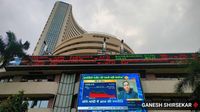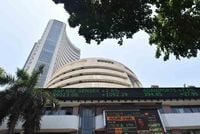The Indian stock market experienced a significant downturn on Thursday, April 3, 2025, following the announcement of reciprocal tariffs by US President Donald Trump. The BSE Sensex saw a decline of over 500 points, while the Nifty 50 hovered near the 23,200 mark, reflecting investor concerns about the global economic impact of these tariffs.
Trump's decision to impose a 26 percent tariff on imports from India was part of a broader strategy aimed at addressing trade deficits with various countries. This tariff rate is notably lower than those imposed on several Asian counterparts, such as Thailand (36 percent) and Indonesia (32 percent). However, it is higher than the tariffs on Japan (24 percent), South Korea (25 percent), Malaysia (24 percent), the European Union (20 percent), and the UK (10 percent).
At 9:57 AM on Thursday, the BSE Sensex had declined by 0.46 percent, or 355.38 points, settling at 76,262.06. Meanwhile, the Nifty 50 fell 0.41 percent, or 95.15 points, to 23,237.20. The early trading session saw a ripple effect across Asian markets, with Hong Kong’s Hang Seng dropping 1.75 percent, the Shanghai Composite falling 0.51 percent, Japan’s Nikkei 225 tumbling 3.14 percent, and South Korea’s KOSPI slumping 1 percent.
Market analysts are expressing concern over the implications of these tariffs. Vikram Kasat, head of advisory at PL Capital – Prabhudas Lilladher, stated, “April 2, 2025, will forever be remembered as the day American industry was reborn, the day America’s destiny was reclaimed, and the day that we began to make America wealthy again. The tariffs Trump unveiled were worse than what the market had established as a worst case scenario.”
In addition to the tariffs on India, Trump announced a base tariff of 10 percent on all countries, set to take effect on April 5, 2025, with higher tariffs for countries with the largest trade deficits starting April 9, 2025. This broad approach has left many investors wary, as the prospect of retaliation from affected countries looms large.
“In very general terms, Canada and Mexico have got off lightly, while those in Asia, particularly China and Vietnam, have been hit hard,” Kasat noted. “The European Union and Japan sit somewhere in the middle. Just the hope – no one retaliates. If you retaliate, there will be escalation. If you don’t retaliate, this is the high-water mark.”
India's export landscape to the US, which totals around $80 billion, includes key sectors such as machinery, apparel, pharmaceuticals, agriculture, electronics, and gems and jewelry. According to Ankita Pathak, a macro strategist at Ionic Asset, these sectors are particularly vulnerable unless exempted from the new tariffs due to non-availability in the US.
Devarsh Vakil, head of prime research at HDFC Securities, warned that the likelihood of a radical escalation in the global trade war has nearly doubled the probability of a recession in the US economy within the next 12 months. In the early trading hours, sectors most affected included Nifty Auto, which fell 1.26 percent, and Nifty IT, which dropped 2.68 percent.
As the market reacted to the tariffs, safe-haven assets like gold saw a surge. Investors sought refuge amid the uncertainty, pushing gold prices to new highs. Oil prices also fell by $2, reflecting concerns over reduced demand for crude amid the escalating trade tensions.
In a broader context, the Indian markets were not alone in their decline. Following Trump's announcement, US stock futures indicated a weak opening for Wall Street, with the Dow Jones futures dropping by 1.94 percent. The sell-off extended to global markets, with many Asian indices mirroring the declines seen in India.
Amidst this turmoil, the rupee fell by 26 paise to 85.78 against the US dollar, further compounding the challenges facing the Indian economy. Forex traders noted that the tariff announcement sparked a risk-averse sentiment among investors, prompting a shift towards safer assets.
Market experts are closely monitoring developments related to trade policies and their economic implications. Anand James, chief market strategist at Geojit Investments, commented on the market's volatility, stating, “While Nifty formed an inside bar candlestick pattern yesterday, broader market risk appetite appears to be improving. If Nifty manages to stay above 23,270 after early volatility, a move towards 23,450 is possible. However, a slide below 23,050-22,960 could indicate further downside.”
In the wake of Trump's tariff announcements, the Indian stock market is expected to face continued fluctuations, influenced by global market reactions and potential retaliatory measures from affected countries. The uncertainty surrounding international trade dynamics is likely to keep investors on edge as they navigate this complex landscape.
In conclusion, the ramifications of Trump's tariffs on India are being felt across various sectors and markets, raising concerns about the future of trade relations and economic stability. As the situation evolves, market participants remain vigilant, hoping for clarity amid the chaos.









